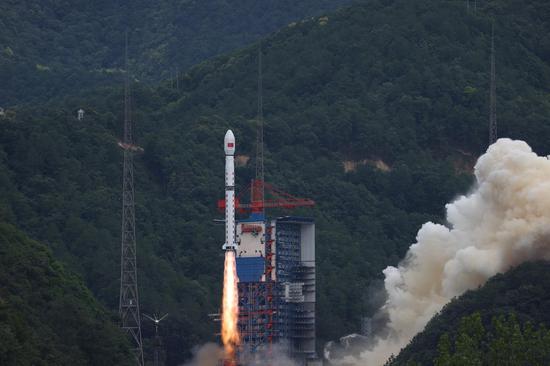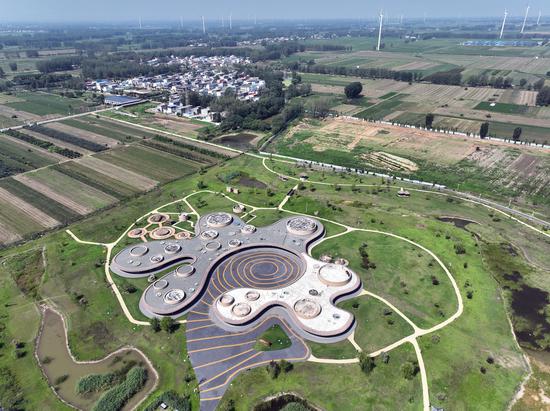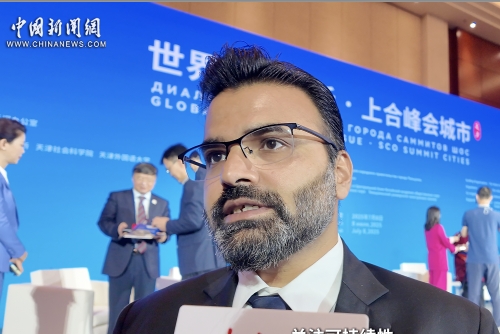CHENGDU — How can people in remote and underdeveloped areas access advanced healthcare services? Can tailored medical solutions meet their unique needs? China, with such questions in mind, is boosting technological advancements to map a healthcare blueprint that benefits the world.
Jotham Kimondo, a 35-year-old doctoral student from Tanzania, is currently studying at the University of Electronic Science and Technology of China in Chengdu, capital of Southwest China's Sichuan province.
Under the supervision of Wu Zhe, a professor at the university and director of the Chengdu Tianfu Jincheng Frontier Medical Equipment Research Institute, Kimondo is focusing on the design of ultrasonic medical devices.
As a faculty member in Tanzania, Kimondo aims to study ultrasonic instrument design and manufacturing in China to benefit his home country.
"My research involves innovative design of ultrasonic medical instruments to monitor the pathological changes of human tissues, which is an important indication of disease. Women in Tanzania still rely on traditional methods like a physician's palpation to check for lumps in the mammary examination. This approach greatly depends on a physicians' individual experience and is not always accurate. Also, some women are not willing to do breast examinations," said Kimondo.
Kimondo added that many diseases still plague the people of Tanzania. "I want to improve healthcare in Tanzania, helping people to maintain health. If we develop more innovative ultrasonic medical equipment together in the future, it would be highly beneficial for early screening of breast diseases and other illnesses in Tanzania, especially after those devices become more convenient and cheaper, and can be better promoted across African countries."
At the Tianfu Jincheng Lab City of Future Medicine, over 53 registered companies related to frontier medicine have been attracted to explore the cutting edge of future medical innovation and integrated medicine.
Recently, at the Remote Ultrasound Center of the Tianfu Jincheng institute, a doctor was talking online with another doctor at the ultrasound department of Chengdu Eastern New Area Second People's Hospital, guiding the use of a portable ultrasound device on a patient's carotid artery.
Real-time imaging and relevant data of the ultrasound inspection were displayed on a shared screen, allowing the two doctors to communicate directly, discuss pathological conditions and give professional diagnostic results.
"Traditional high-end ultrasound machines are expensive, costing millions. Rural residents in China's western regions often need to seek ultrasound examinations in higher-level county hospitals," Wu explained.
"Our research efforts aim to enable portable ultrasound devices to be widely used in rural areas of western China for early disease screening and chronic disease management. Compared to high-end ultrasound machines, our portable device significantly lowers costs. Additionally, it is simpler and more convenient to use in grassroots hospitals," Wu added.
Use of this portable ultrasound device, which is the size of a smartphone, has already been implemented in over 10 health centers in Chengdu — providing free carotid and thyroid screenings to more than 2,000 residents.
With the continuous improvement of China's industrial design and manufacturing capabilities and medical research levels, innovation in the development of medical devices is soaring. The growing recognition of Chinese medical devices in overseas markets is resulting in increasing international orders, encouraging more Chinese medical companies to go global.
In the City of Future Medicine, an industrial park, workers at Chengdu Seamaty Technology Co Ltd are packing biochemical analysis reagents. This batch of goods is set to be shipped globally from Chengdu.
This "little giant" firm, which refers to novel and elite small and medium-sized enterprises that specialize in a niche market, boasts cutting-edge technologies and shows great potential, focusing on the research and production of point-of-care testing medical devices. The firm has already sold its medical products to more than 150 countries and regions worldwide.
In its quality inspection center, hundreds of fully automated biochemical analyzers undergo pre-shipment quality checks.
"This shipment of instruments will be sent to Europe. Last year, our company's total sales reached 320 million yuan ($44.6 million), and in the first five months of this year, our international business increased by 59 percent compared to the same period last year," said Wang Bin, deputy general manager of the company, highlighting that the growth in overseas orders reflects an increasing acceptance of Chinese medical device manufacturing products in international markets.
Innovative technologies such as 3D printing, organ-on-chip systems, nanorobots and brain-computer interfaces are advancing the scientific research applications of medical devices in China, presenting a future-oriented medical landscape.
At Chengdu Tianqi Additive Intelligent Manufacturing Co Ltd, personalized patient-matched medical solutions are being precisely created with 3D printing technology. It uses computer-aided design and manufacturing modeling, and a layer-by-layer printing process to turn virtual designs into physical products, making the envisioned design a tangible reality.
In a modern manufacturing workshop, dozens of industrial printers operate in an orderly manner, with a laser engraver precisely etching patterns in titanium alloy powder to an accuracy of 0.01 millimeter.
Within just a few hours, products such as patient-matched maxillofacial bone plates are printed. This seemingly ordinary industrial scene reflects significant advancements that China has made in the realm of precision medical manufacturing.
Compared to the handmade bending of bone plates in the past, 3D printing offers a more precise, convenient, safe and stable way to create customized products.
"We are currently conducting custom production for a case in Singapore. Engineers input patient data transmitted from the hospital into the system and the AI algorithms aid designers in creating personalized data models for patient facial reconstruction, which are then integrally formed via metal 3D printers," said Gao Bangkui, marketing director of Chengdu Tianqi Additive lntelligent Manufacturing Co Ltd.
Gao added that in the future, the company will prioritize serving the Middle East, Africa and Southeast Asia to meet the customized medical needs of countries and regions participating in the Belt and Road Initiative.


















































 京公網(wǎng)安備 11010202009201號
京公網(wǎng)安備 11010202009201號